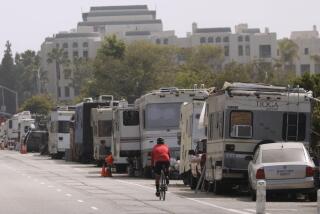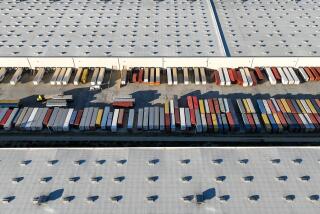Bill Banning Trash Dumps in Mountains Clears Hurdle
SACRAMENTO — Legislation to outlaw trash landfills in the Santa Monica Mountains cleared its first key hurdle this week, winning strong bipartisan support from the Assembly’s Natural Resources Committee.
The 7-2 vote, which sends the bill to the Ways and Means Committee for a vote expected late next month, came despite amendments added last week to include vast portions of the San Fernando Valley, raising the stakes in the growing battle over Los Angeles city garbage.
The bill now would prohibit landfill operations in 155,000 acres of the Santa Monica Mountains--including Mission, Rustic and Sullivan canyons--and in 140,000 acres in the Rim of the Valley Corridor. That rugged mountain land, which almost encircles the Valley, includes two of the city’s largest existing landfills in Sunshine and Lopez canyons.
1990 Deadline
Those landfills would be forced to close by 1990, a requirement that would effectively kill controversial expansion plans for Sunshine Canyon.
“This makes the bill much more a frontal attack on landfills,” said Assemblyman Terry B. Friedman (D-Tarzana), who introduced the bill in March to protect federal parkland in the Santa Monica Mountains. Friedman said he revised the bill at the request of Assemblywoman Marian W. LaFollette (R-Northridge), whose constituents have battled nearly a year to block a proposed 1,000-acre expansion of the Sunshine Canyon landfill.
LaFollette’s support helped ensure bipartisan endorsement for the measure, Friedman said in an interview. Although the amendments may generate strong opposition, Friedman predicted that “continuation of (that) bipartisan support will mean victory” as the bill moves through the Legislature.
“It seems to me the last thing we ought to do with national and state parkland is to turn it into a garbage dump,” the freshman assemblyman told resource committee members. Congress designated the Santa Monica Mountains as a national recreation area in the late 1970s, Friedman added. “We’re simply tying the knot that was . . . loosely fitted 10 years ago.”
‘Dandy Little Crisis’
Critics, however, blasted the bill as a potentially fatal blow to regional waste planning. Los Angeles’ existing landfills, including Sunshine and Lopez canyons, are due to be filled by the early 1990s, according to county waste management officials.
“We’re going to have a dandy little crisis here in about two more years, when that existing capacity is gone,” county Supervisor Pete Schabarum said Tuesday. “If that bill is adopted . . . somebody’s going to have to ask the city of Los Angeles where it is going to dispose of trash.”
Los Angeles, which produces about 16,500 tons of trash each day, would have little choice but to seek new landfill sites in areas such as the San Gabriel, Santa Clarita and Antelope valleys, Schabarum said. But the supervisor vowed to fight to keep the garbage inside city limits.
“If (city officials) think we’re going to open another landfill in the north part of Los Angeles County, they’re crazy,” Schabarum said. “We’re going to tighten the noose even further.”
Although the bill has been supported by Mayor Tom Bradley and Councilman Marvin Braude, whose district encompasses much of the Santa Monica Mountains, it has drawn criticism from Councilman Ernani Bernardi, whose district lies in the San Fernando Valley.
Bernardi, a supporter of county efforts to reopen a closed dump site at Mission Canyon, also wondered where the trash would go. In an interview Tuesday, he said supporters of the measure seem unwilling to face the “seriousness of the waste disposal problem.”
“It’s not going to go away, it’s going to get worse,” Bernardi said. “They don’t want (the trash) in Palmdale. They don’t want it in Lancaster. What are we going to do after 1990? Put it in the streets? In backyards?”
Friedman said he is unsure where the trash should go, except that it should be away from homes and parkland. He said additional hauling costs would be far less than the medical costs that could result from public exposure to garbage.
LaFollette, a resource committee member who joined homeowners and conservation groups in supporting the bill Monday, blamed existing landfills for contaminating city ground water.
“More and more wells in the San Fernando Valley have been determined to be contaminated,” LaFollette said. “Rainwater on our landfills is contributing to contamination. Health has to be our No. 1 concern.”
More to Read
Get the L.A. Times Politics newsletter
Deeply reported insights into legislation, politics and policy from Sacramento, Washington and beyond. In your inbox three times per week.
You may occasionally receive promotional content from the Los Angeles Times.










